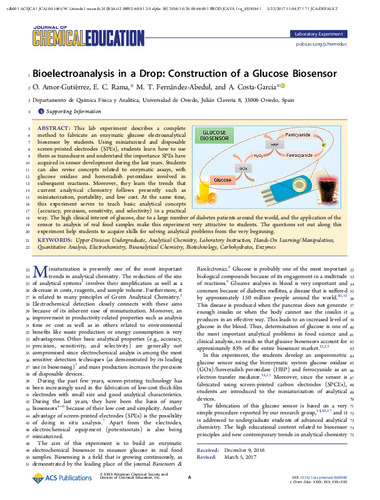Bioelectroanalysis in a Drop: Construction of a Glucose Biosensor
Subject:
Upper-Division Undergraduate
Analytical Chemistry
Publication date:
Publisher version:
Citación:
Descripción física:
Abstract:
This lab experiment describes a complete method to fabricate an enzymatic glucose electroanalytical biosensor by students. Using miniaturized and disposable screen-printed electrodes (SPEs), students learn how to use them as transducers and understand the importance SPEs have acquired in sensor development during the last years. Students can also revise concepts related to enzymatic assays, with glucose oxidase and horseradish peroxidase involved in subsequent reactions. Moreover, they learn the trends that current analytical chemistry follows presently such as miniaturization, portability, and low cost. At the same time, this experiment serves to teach basic analytical concepts (accuracy, precision, sensitivity, and selectivity) in a practical way. The high clinical interest of glucose, due to a large number of diabetes patients around the world, and the application of the sensor to analysis of real food samples make this experiment very attractive to students. The questions set out along this experiment help students to acquire skills for solving analytical problems from the very beginning.
This lab experiment describes a complete method to fabricate an enzymatic glucose electroanalytical biosensor by students. Using miniaturized and disposable screen-printed electrodes (SPEs), students learn how to use them as transducers and understand the importance SPEs have acquired in sensor development during the last years. Students can also revise concepts related to enzymatic assays, with glucose oxidase and horseradish peroxidase involved in subsequent reactions. Moreover, they learn the trends that current analytical chemistry follows presently such as miniaturization, portability, and low cost. At the same time, this experiment serves to teach basic analytical concepts (accuracy, precision, sensitivity, and selectivity) in a practical way. The high clinical interest of glucose, due to a large number of diabetes patients around the world, and the application of the sensor to analysis of real food samples make this experiment very attractive to students. The questions set out along this experiment help students to acquire skills for solving analytical problems from the very beginning.
ISSN:
Patrocinado por:
This work was supported by the FC-15-GRUPIN-021 Project from the Asturias Regional Government and the CTQ2014- 58826-R Project from the Spanish Ministry of Economy and Competitiveness (MINECO).
Collections
- Artículos [36139]
- Investigaciones y Documentos OpenAIRE [7870]
- Química Física y Analítica [597]
Files in this item




